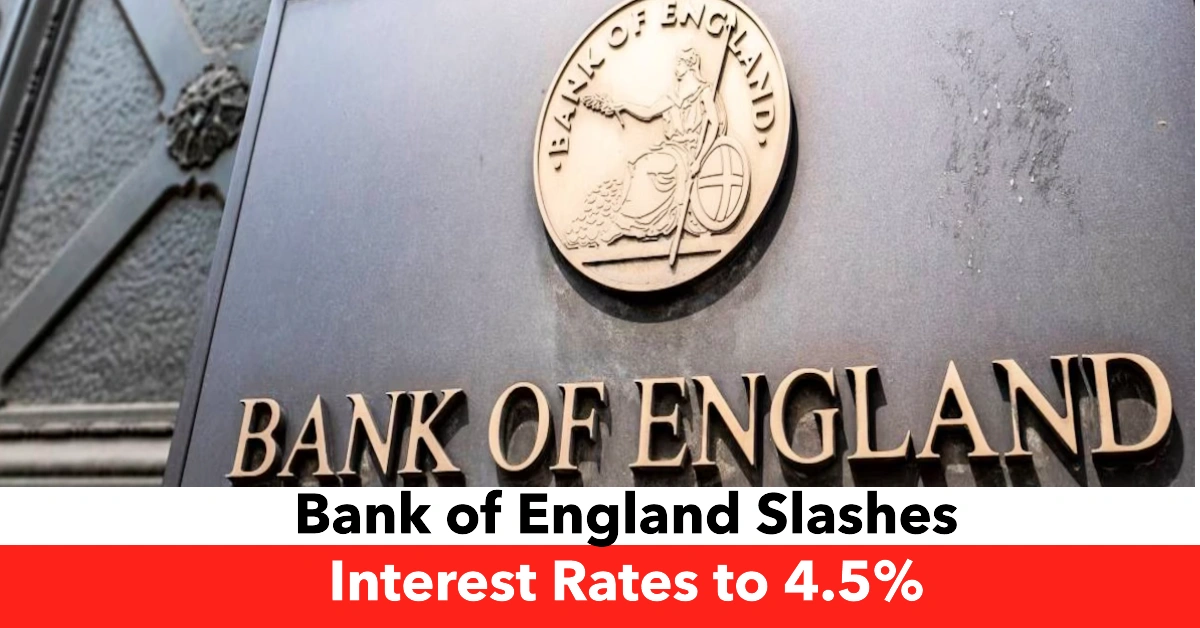The Bank of England (BoE) has cut interest rates to 4.5%, a move aimed at providing financial relief to borrowers amidst an increasingly sluggish economy. However, the decision comes with a stark warning that inflation is expected to peak at 3.7% by autumn, placing further pressure on households.
UK Economy Faces Stagflation as Growth Forecast Halved
The central bank’s Monetary Policy Committee (MPC) voted seven to two in favor of a quarter-point reduction, bringing borrowing costs to their lowest level since June 2023. This rate cut is coupled with a sharp downgrade in the UK’s growth forecast, reducing expected GDP growth for 2025 from 1.5% to 0.75%.
Table of Contents
BoE Governor Warns of Economic Uncertainty
Bank of England Governor Andrew Bailey acknowledged the mixed impact of the rate cut, stating:
“It will be welcome news to many that we have been able to cut interest rates again today. We’ll be monitoring the UK economy and global developments very closely and taking a gradual and careful approach to reducing rates further.”
Despite the relief for borrowers, concerns over inflationary pressures remain, particularly with rising energy prices, growing international trade tensions, and domestic policy challenges.
The Real Culprit Behind the UK Housing Crisis: It’s Not Immigrants, It’s Internal Migration
Over a Million Taxpayers Miss Deadline: What Happens Next and How to Avoid Penalties
Why Did the Bank of England Cut Interest Rates?
The decision to lower rates comes in response to weak economic growth and a slowdown in business confidence following the Chancellor’s October 2024 budget. Recent inflation data showed a better-than-expected cooling, with inflation falling to 2.5% in December 2024, down from 2.6% in November.
However, two members of the MPC, Catherine Mann and Swati Dhingra, pushed for an even larger half-point cut to 4.25%, signaling growing concerns about economic stagnation.
Stagflation Fears: High Inflation and Weak Growth
Deteriorating Economic Growth
The UK economy is teetering on the brink of stagflation, a scenario where weak economic growth is combined with persistent inflation. The BoE now expects:
- A 0.1% decline in GDP in the final quarter of 2024
- Minimal 0.1% growth in early 2025
- Sluggish overall GDP expansion of 0.75% in 2025 (down from the previous 1.5% forecast)
Inflationary Pressures on Households
Households are likely to see renewed financial strain as inflation is forecast to rise again, reaching 3.7% by Q3 2025. The Bank attributes this to:
- A cold European winter driving up wholesale energy prices
- Higher utility bills
- Broader cost of living pressures
Despite the concerns over short-term inflation, the BoE believes inflation will eventually decline, reaching the government’s 2% target by the end of 2027.
Impact of Rate Cut on Mortgages and Savings
For Homeowners and Borrowers
A reduction in interest rates generally lowers mortgage repayments, particularly for those on:
- Variable-rate mortgages
- Tracker mortgages tied to the BoE base rate
However, fixed-rate mortgage holders will not benefit until they refinance. The rate cut may also increase demand in the housing market, potentially stabilizing property prices.
For Savers
While lower interest rates are beneficial for borrowers, they can negatively impact savings accounts, as banks often pass rate cuts onto depositors. Savers may see:
- Lower returns on fixed savings accounts
- Reduced interest on ISAs and standard savings accounts
Global Economic Risks and UK Trade Uncertainty
The BoE also flagged international risks, particularly regarding US trade policies under Donald Trump’s potential tariffs. If implemented, these tariffs could:
- Disrupt global trade
- Trigger increased trade fragmentation
- Slow down world economic activity
The Bank warned that the UK would not be immune to the negative economic impact of growing global protectionism.
Business and Labour Market Challenges
Higher Costs for Employers
The BoE’s concerns are echoed by UK industry groups, warning that recent government measures could increase financial strain on businesses. The upcoming changes include:
- £25bn increase in employers’ National Insurance contributions
- 6.7% rise in the minimum wage (effective from April 2025)
Businesses fear these costs could force them to:
- Cut jobs
- Raise prices, further fueling inflation
Chancellor Faces Fiscal Challenges
Chancellor Rachel Reeves has come under scrutiny for rising government borrowing costs, driven by expectations of higher-for-longer interest rates in the UK and US. Market analysts suggest this could lead to potential breaches of the government’s fiscal rules.
What’s Next for UK Interest Rates?
While the quarter-point cut offers some relief, many experts believe the BoE’s ability to cut rates further is limited by inflation concerns. Any further rate reductions will depend on:
- The trajectory of inflation over the next six months
- Employment market trends
- Global economic developments
DWP Confirms No Plans for New £301 Cost of Living Payments—What It Means for Struggling Households
How Much State Pension Increase for 2025? Payment Dates & New Rates
State Pension Back Payments: Women in Their 60s and 70s Could Receive Nearly £8,000 by Year-End
Conclusion: A Balancing Act Between Growth and Inflation
The Bank of England’s latest move underscores the fragile state of the UK economy. While a lower base rate may ease borrowing costs, the accompanying stagnant growth outlook and rising inflationary pressures suggest that economic recovery remains a challenge.
As households brace for another wave of higher living costs, businesses navigate rising operational expenses, and the UK faces global trade risks, all eyes remain on the BoE’s next moves in monetary policy and the government’s response to fiscal pressures.
The coming months will be crucial in determining whether the UK can navigate its way out of stagflation, or whether further financial hardships are on the horizon.

